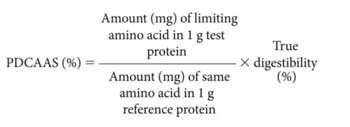What is PDCAAS?
PDCAAS is a method of evaluating the quality of a protein, it considers the amino acid contents of the protein and its digestibility.
The PDCAAS method assigns scores based on a standard amino acid profile. The score 1 means that after digestion of the protein, it provides per unit of protein, 100% or more of the essential amino acids required.
The formula for calculating the PDCAAS percentage is:
(mg of limiting amino acid in 1 g of test protein / mg of same amino acid in 1 g of reference protein) x fecal true digestibility percentage.[1]
The PDCAAS measures the quality of a protein based on the amino acid requirements of a 2- to 5-year-old child, humas at this stage are considered the most nutritionally demanding age group.

Limitations to PDCAAS
For example, grain protein has a PDCAAS of about 0.4 to 0.5 because of its low content of lysine, but it contains more than enough methionine. White bean protein has a PDCAAS of 0.6 to 0.7, it contains low levels of methionine, but contains more than enough lysine. When both are eaten in roughly equal quantities in a diet, the PDCAAS of the combined constituent is 1.0, because these proteins complement each other.
Digestion
Some amino acids move beyond the terminal ileum in our body, these amino acids are less likely to be absorbed for use in protein synthesis. It would appear as if they were digested, when in fact they might have passed out of the body or absorbed by bacteria, adn not present in the feces analysis.
